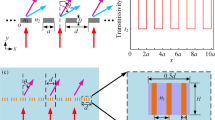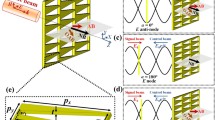Abstract
We propose a plasmonic superlattice with nonlinear Kerr medium in defect layer to realize slow light effect and demonstrate the group velocity control at telecom waveband (1550 nm) by peak intensity of input pulse. The tunable group velocity of surface plasmon polaritons is attributed to the change of dispersion of the superlattice caused by nonlinear Kerr effect. The method of controlling group velocity is analyzed by transfer matrix method based on characteristic impedance and confirmed by the finite-difference time-domain numerical simulation. Our method of control group velocity potentially applies in the tunable optics delay line.






Similar content being viewed by others
References
Hau LV, Harris SE, Dutton Z, Behroozi CH (1999) Light speed reduction to 17 metres per second in an ultracold atomic gas. Nature 397:594–598
Bigelow MS, Lepeshkin NN, Boyd RW (2003) Superluminal and slow light propagation in a room-temperature solid. Science 301:200–202
Schneider T (2008) Time delay limits of stimulated-Brillouin-scattering-based slow light systems. Opt Lett 33:1398–1400
Baba T (2008) Slow light in photonic crystals. Nat Photonics 2:465–473
Li CL, Zhang XR, Wang YX, Song YL, Kong DG, Wang YK (2012) Slow surface plasmon polaritons with a large normalized delay bandwidth product in an ultracompact metal gap superlattice. Opt Commun 285:1993–1996
Kang ZW, Lin WH, Wang GP (2009) Dual-channel broadband slow surface plasmon polaritons in metal gap waveguide superlattices. J Opt Soc Am B 26:1944–1948
Zhang J, Cai L, Bai W, Xu Y, Song G (2009) Slow light at terahertz frequencies in surface plasmon polariton assisted grating waveguide. J Appl Phys 106:103715
Xu Y, Zhang J, Song G (2013) Slow surface plasmons in plasmonic grating waveguide. IEEE Photon Technol Lett 25:410–413
Wang G (2013) Slow light engineering in periodic-stub-assisted plasmonic waveguide. Appl Opt 52:1799–1804
Fitrakis EP, Kamalakis T, Sphicopoulos T (2011) Slow light in insulator-metal-insulator plasmonic waveguides. J Opt Soc Am B 28:2159–2164
Fitrakis E, Kamalakis T, Sphicopoulos T (2010) Slow-light dark solitons in insulator-insulator-metal plasmonic waveguides. J Opt Soc Am B 27:1701–1706
Hu H, Ji D, Zeng X, Liu K, Gan Q (2013) Rainbow trapping in hyperbolic metamaterial waveguide. Sci Rep 3:1249
Gan QQ, Fu Z, Ding YJ, Bartoli FJ (2008) Ultrawide-bandwidth slow-light system based on THz plasmonic graded metallic grating structures. Phys Rev Lett 100:256803
Chen L, Wang GP, Gan QQ, Bartoli FJ (2009) Trapping of surface-plasmon polaritons in a graded Bragg structure frequency-dependent spatially separated localization of the visible spectrum modes. Phys Rev B 80:161106
Wang G, Lu H, Liu X (2012) Trapping of surface plasmon waves in graded grating waveguide system. Appl Phys Lett 101:013111
Guo J (2014) Plasmon-induced transparency in metal-insulator-metal waveguide side-coupled with multiple cavities. Appl Opt 53:1604–1609
Han X (2014) Dual-channel dispersionless slow light based on plasmon-induced transparency. Appl Opt 53:9–13
Zafar R (2014) Wideband slow surface plasmons in double resonator plasmonic grating waveguide. IEEE Photon Technol Lett 26:2221–2224
Yang L, Min C, Veronis G (2010) Guided subwavelength slow-light mode supported by a plasmonic waveguide system. Opt Lett 35:4184–4186
Balci S, Kocabas A, Kocabas C, Aydinli A (2010) Slowing surface plasmon polaritons on plasmonic coupled cavities by tuning grating grooves. Appl Phys Lett 97:131103
Li CL, Zhang XR, Wang YX, Song YL, Kong DG, Wang YK (2011) Precise control of group velocity by pulsewidth in a plasmonic superlattice. IEEE Photon Technol Lett 23:1243–1245
Park J, Kim K Y, Lee I M, Na H, Lee S Y, Lee B (2010) Trapping light in plasmonic waveguides. 18:598–623
Min C, Wang P, Jiao X, Deng Y, Ming H (2007) Beam manipulating by metallic nano-optic lens containing nonlinear media. Opt Express 15:9541–9546
Ginzburg P, Orenstein M (2007) Plasmonic transmission lines: from micro to nano scale with lambda/4 impedance matching. Opt Express 15:6762–6767
Kocabas SE, Veronis G, Miller D a B, Fan SH (2008) Transmission line and equivalent circuit models for plasmonic waveguide components. IEEE J Sel Top Quantum Electron 14:1462–1472
Liu JL, Lin J, Zhao HF, Zhang Y, Liu ST (2010) Numerical analysis of surface plasmon nanocavities formed in thickness-modulated metal-insulator-metal waveguides. Chin Phys B 19:054201
Li C, Zhang X, Wang Y, Song Y (2013) Fine tuning slow group velocity and small pulse broadening of surface plasmon polaritons along metal—nonlinear Kerr medium interface. 298–299:246–249
Acknowledgments
This work is supported by the Fundamental Research Funds for the Central Universities of China. (No. DL13BB15)
The Ethical Statement
-
The manuscript has not been submitted to more than one journal for simultaneous consideration.
-
The manuscript has not been published previously (partly or in full), unless the new work concerns an expansion of previous work.
-
A single study is not split up into several parts to increase the quantity of submissions and submitted to various journals or to one journal over time.
-
No data have been fabricated or manipulated (including images) to support our conclusions
-
No data, text, or theories by others are presented as if they were the authors’ own.
Author information
Authors and Affiliations
Corresponding author
Rights and permissions
About this article
Cite this article
Li, C., Xin, J., Tang, D. et al. Control of Group Velocity Based on Nonlinear Kerr Effect in a Plasmonic Superlattice. Plasmonics 10, 1593–1596 (2015). https://doi.org/10.1007/s11468-015-9984-4
Received:
Accepted:
Published:
Issue Date:
DOI: https://doi.org/10.1007/s11468-015-9984-4




